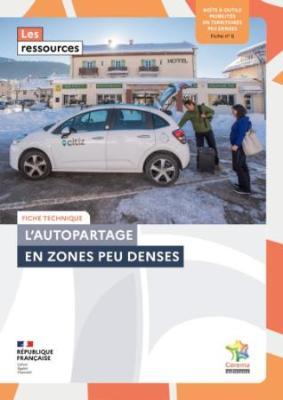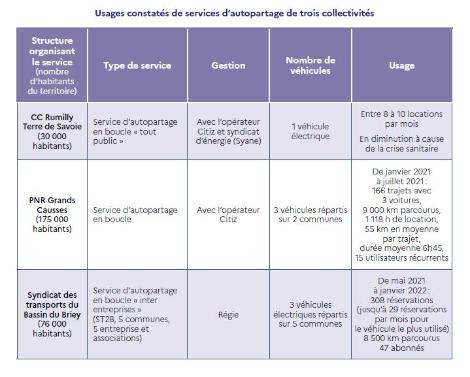Car-sharing in sparsely populated areas
October 2023
According to the French Transport Code, ‘car-sharing is the pooling of a vehicle or a fleet of motorised land transport vehicles for the benefit of users who are subscribers or authorised by the organisation or person managing the vehicles. Each subscriber or authorised user has access to a driverless vehicle for the journey of their choice and for a limited period of time’.
A car-sharing service is therefore a service that makes a vehicle available in a given area, with access made possible for a set period of time. The use of a vehicle requires registration by the driver, and may require the vehicle to be reserved in advance. Although not included in the legal definition of car-sharing, a number of criteria identified by the Association des acteurs de l’autopartage help to characterise car-sharing services and differentiate them from other forms of hire or use. Here’s how it works.
To download : 5_autopartage-web.pdf (1.4 MiB)
1 OBJECTIVES OF A CARSHARING SERVICE

Setting up a carsharing service in a sparsely populated area can make it possible to :
-
offer a new, practical and specific mobility solution for a wide range of people who do not have their own vehicle: economically vulnerable people, jobseekers, tourists, the elderly, etc. ;
-
reduce mobility costs for individuals who only need to travel occasionally (holidays, etc.), and for professionals such as local authorities and businesses who want to pool their fleets to optimise use;
-
develop sustainable mobility practices: the use of a car-sharing vehicle replaces or avoids the purchase of a 2nd vehicle that is rarely used, thus reducing the amount of parking space in public spaces, or even rationalising users’ car travel habits, or promoting the use of electric, hybrid or hydrogen-powered vehicles.
Types of car-sharing services
There are several types of car-sharing service, with or without a car-sharing station:
-
loop carsharing: the vehicle is picked up and dropped off at the same place in a carsharing station. This type of service requires the vehicle to be reserved for a specific time slot, thereby guaranteeing the availability of the reserved vehicle. It is the most common form of service and allows for better fleet management and operation. The associated charges are generally based on an hourly rate plus a charge per kilometre;
-
direct return carsharing: the vehicle is dropped off at a carsharing service station, which may be different from the station of departure. This carsharing model is not very widespread today;
-
free-floating car-sharing: the vehicle does not need to be returned to the same place as the point of departure, and is dropped off at a ‘traditional’ on-street parking space. Reservations are not required before departure. This model is being developed in densely populated areas, often charging by the minute.
In sparsely populated areas, local authorities tend to opt for loop carsharing systems, which are best suited to local needs and resources. The rest of this document will therefore focus on this type of service.
2 ORGANISING A CARSHARING SERVICE
Mobility organising authorities (AOMs) are responsible for organising carsharing services or contributing to their development. They can set up a public carsharing service where private provision is non-existent, insufficient or unsuitable.
Setting up a car-sharing service may also require powers over roads and parking, often held by the local authority or EPCI, depending on the area. In particular, the road manager may issue an authorisation for temporary occupation of the public domain for the parking of car-sharing vehicles.
There are several ways of managing the service:
-
Own management by the AOM (régie) In this case, the operation of the service (vehicle reservations, routine maintenance, administrative follow-up, registration/subscription of service users, etc.) is carried out by AOM staff: 0.3 to 1.5 full-time equivalents (FTE) are generally deployed;
-
management of the service by an operator (public service delegation or public contract) Management may be entrusted in whole or in part to an operator. The operator may, for example, be responsible for managing registrations, reservations and vehicle maintenance, while the local authority is responsible for communicating the service and providing information to users. The number of local authority FTEs dedicated to the service is lower than in the case of an operator (between 0.2 and 0.8 FTE, depending on the tasks retained by the local authority).
In both cases (public service or contract with an operator):
-
the vehicles can be made available both to the authority’s employees (particularly for their work-related travel) and to local residents (or visitors) (within the framework of the 4 The AOM can contribute to the development of a car-sharing service, subject to compliance with the principle of equal treatment between operators within the framework of the use of the car-sharing service). This enables resources to be pooled and the service to be more cost-effective;
-
the local authority can develop the carsharing service in partnership with local structures (companies, municipalities, etc.) that make their vehicle(s) available. 0.5 to 1.5 FTEs are then required to manage partnerships with these local structures.
If management is outsourced to an operator, the vehicles may also belong (in whole or in part) to the operator.
The choice of how the service is operated is particularly important in terms of its impact on the number of FTEs the local authority needs to mobilise.
A car-sharing service can also be organised by a private operator on its own initiative. In this case, the AOM can be involved in the project and, under certain conditions, contribute to the development of the service (technical or financial participation, mobility advice for employers, etc.).
3 - EXAMPLES OF USE OF CAR-SHARING SERVICES
The table below shows the observed use of loop car-sharing services organised by three local authorities. The data is purely illustrative, as usage can vary significantly from one area to another for a similar service.

4 - COSTS AND FUNDING
4.1 Costs
The fixed monthly costs of the service depend directly on the number of vehicles made available and the type of engine used. There is often a correlation between the number of vehicles available and the population of the area.
Investment can be reduced if the service operates in partnership with an organisation that supplies vehicles, or in partnership with local companies or energy associations that already have charging stations in the area. Other investments are to be expected, such as the installation of signage.
4.2 Revenue and funding
Car-sharing services are mainly financed by :
-
fare income (which varies according to the fare applied and the use made of the service) ;
-
possible subsidies ;
-
the mobility payment, when levied by the AOM.
Service charges vary between €1.5 and €5 per hour, to which may be added a cost per kilometre (between 0.15 and 0.5 ct/km). Some car-sharing services can operate on a monthly subscription basis, which is less expensive for regular users (between €5 and €8/month for individuals and between €10 and €15/month for businesses for car-sharing services in less densely populated areas).
Some car-sharing services benefit from subsidies, in particular through calls for expressions of interest such as the AMI Tenmod from Ademe, which may have financed the implementation or launch of the service.
These grants can also be used to finance
-
a mobility project manager post (PNR Grands Causses - TenMod AMI winner, 3-year post);
-
the services of an operator (Communauté d’agglomération Privas Centre Ardèche);
-
the fleet of vehicles (Syndicat des transports du bassin de Briey);
-
or the installation of charging stations (Coeur du Pays Haut Community of Communes), which will contribute to the smooth running of the service.
Where the local authority is responsible for creating and operating recharging stations, the use of publicly accessible stations shared with those of the car-sharing service can also be a source of revenue.
5 - APPROACH TO SETTING UP A PROJECT
Setting up a car-sharing service requires preliminary studies to identify the needs of the area, identify the appropriate operating method, size the service, etc. If the service is to be managed by an operator, a call for tenders is required to recruit the operator, before the service operating agreement defining the responsibilities of the local authority and the operator is drawn up. In particular, it is a good idea for the contract between the local authority and the operator to allow a degree of flexibility to adjust the service after an initial test period, depending on user feedback and vehicle usage. It is also a good idea to provide for data feedback on the use of the service (usage rates, journey times and distances, user profiles, etc.), or even user surveys.
6 EXAMPLE OF THE IMPLEMENTATION OF A CAR SHARING SERVICE BY THE PNR DES GRANDS CAUSSES
Since October 2019, the Parc naturel régional (PNR) des Grands Causses has set up a car sharing service with the operator Citiz Occitanie. This example illustrates the process of setting up a car-sharing service in a sparsely populated area.
Studies
As part of this process, the PNR Grands Causses asked the Indiggo consultancy firm to carry out a feasibility study to find out what form of car-sharing would be most appropriate in the area.
Call for tenders
Following this feasibility study, the RNP launched a call for tenders. The operator Citiz Occitanie was selected.
Agreement
The agreement with Citiz was signed for a period of 3 years. The NRP has also become a member of Citiz’s Société coopérative d’intérêt collectif (SCIC). Revenues are shared 50% between the NRP and Citiz until the operating costs incurred by the NRP are reimbursed.
In addition, for this service, the fleet is made up of vehicles made available by local organisations (the Regional Nature Park, Saint-Affrique town hall and a local construction company). The NRP therefore has an agreement with Citiz and an agreement with each of the parties making a vehicle available.
Parallel stages
As far as communication is concerned, the task is divided 50/50 between the Regional Nature Park and the Citiz operator. A major promotional campaign was carried out by the Regional Nature Park: local organisations (driving schools, businesses, shopkeepers, etc.) were informed of the introduction of the service, and the Regional Nature Park set up information stands in front of supermarkets and at markets. The NRP also produced a clip for the cinema, passed on information to radio stations and social networks, distributed flyers and wrote press articles in local newspapers.
Experimentation and launch
The NRP car-sharing service was launched with four vehicles. The NRP wanted to expand its service and launched a new call for tenders. CLEM and Citiz responded, and Citiz was selected.
For this second phase, the NRP’s objective is to develop around twenty more stations: the organisation has also signed an agreement with a hotel that will make its vehicle available to the service. The business model will remain the same, but the NRP wants the vehicles to be more diversified.
Work has also been carried out to review the pricing of the service: the NRP wants the price to be the same for everyone.
Finally, thanks to this second phase, the NRP has also been able to organise vehicle purchasing pools, which have benefited the communities of communes and municipalities.
7 CONCLUSION
Car-sharing services can be an appropriate response for sparsely populated areas, complementing other mobility services integrated into a multimodal package of services for all the area’s inhabitants.